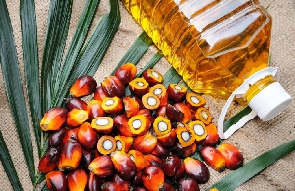 Oil palm is a key export commodity
Oil palm is a key export commodity
Trade data obtained from the Oil Palm Development Association of Ghana (OPDAG) indicates that the country imported some US$1.17billion worth of oil palm between 2019 and 2021, a commodity which can be produced locally.
The association’s President, Samuel Avaala, told the B&FT that lack of best practices in production and milling is causing the state to lose millions of export revenue from the commodity.
Despite having the potential to become a net exporter, he said the country has become a net importer of oil palm as it shipped in 1.17 million metric tonnes of palm oil from 2019 to 2021 while producing about 850,000 tonnes within the same period.
Though Wilmar Africa and the Benson Oil Palm Plantation refine and produce crude palm, these two companies export a chunk of their products to the Sahel regions and other parts in the sub-region.
Refining almost 1000 metric tonnes per day, both Wilmar and Benson export about 600,000 tonnes in both refined and crude palm each year to countries, including Mali, Burkina Faso, Niger, and others.
With domestic consumption of palm oil hovering around 400,000 tonnes, Mr. Avaala is of the opinion that priority should be given to domestic production to reach two million tonnes annually to reduce the weight of imports on the economy, and to create employment for young people.
Currently, Indonesia and Malaysia produce more than 90 percent of the world’s consumable palm oil. Data from the OPDAG shows that Africa consumes 13 percent of global palm oil but produces just about four percent of the commodity.
“We need to cultivate about 200,000 hectares to meet the targetted expansion and to halt the escalating imports,” Mr. Avaala said.
Issues of best practices
The key challenge to the domestic production remains the fact that small-scale producers are in charge of more than 70 percent production.
Similarly, oil extraction and processing are largely done by small artisanal millers. With little or no use of technology in the sector, oil extracting rate is lower, and waste contains fibre content higher than the actual oil extracted.
These small producers and artisanal millers are not only limited in capacity, but they also lack best practices.
For instance, a standard palm farm per hectare should give the farmer about 18-25 tonnes of fresh fruits per year, but small-scale producers in the country, according to the OPDAG, get less than six tonnes per hectare.
Whereas the oil extracting rate should ideally be 20-25 percent per tonne, artisanal millers are doing 11-13 percent.
“Intensification must be done to double the current production to at least 50 percent. Adoption of best practices at the farm level and at mills should be prioritised,” he advocated.
In Africa, Nigeria used to be the leading palm oil producer, but abandoned it after it discovered oil. Currently, Ivory Coast is the only net exporter of palm oil in Africa.
Watch the latest edition of BizTech and Biz Headlines below:
Watch the latest edition of Business Moments below: